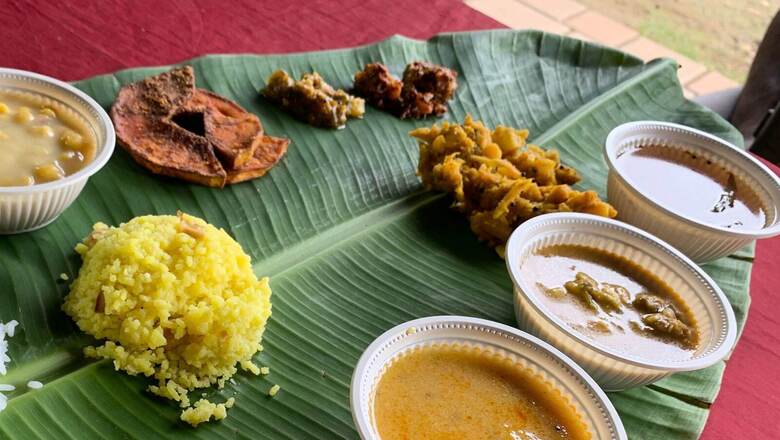
views
For this month, most Hindus give up meat and alcohol. Shravan is the fifth month of the Hindu calendar and is especially important because not only is it a month full of religious and cultural festivals, like Janmashtami, Raksha Bandhan, Nariyal Poornima, and Nag Panchami, but it also heralds the arrival of the south-west monsoons. Hence these are the months when it is difficult to face the ravages of the tides and also when most fish spawn, so fisherfolk abstain from going out to fish, which also explains the vegetarian habits of those living on the coast during this month.
Celebrating Shravan at Home
We grew up celebrating this month of Shravan with great gusto. It was, like any other festival, great fun because the rest of the family came over to my grandparents’ large flat near Marine Drive where we lived in a joint family. Every Monday and Saturday of this month, the kitchen was abuzz with activity. Interestingly, this flat had two kitchens and one pantry. Originally one kitchen was exclusively reserved for vegetarian cooking and the other for fish and meat, and had been set up separately by my great-grandmother. Of course, things had changed once she passed on. But Shravan brought a sort of renaissance in the kitchen, which was tired of the mundane chores of daily cooking. Although for my predominantly meat- and fish-eating family, fasting during this month of Shravan would be limited to Shravan Somvar and Shravan Shanivar which is just Mondays and Saturdays, there was always such excitement.
My grandmother would organise the lunch, the cook and the other help taking instructions from her. A word about my grandmom. She would have been 100 this year and she loved her kitchen. Even in her eighties, she’d sit on the floor in her nine-yard saree, astride a “vili” or “morli”—a short wooden stool with a sharp, curved perilous-looking blade attached to it. The blade was used to slice anything and everything, from fish to fowl and cabbage to karela. At the end of the blade was a serrated disc on which you could grate a coconut. This way both her hands were free to hold the pomfret, leg of mutton or vegetable and to artfully cut it the way she wanted to.
ALSO READ | What The Fork: Kunal Vijayakar on Varan Bhaat, the Food That Describes a Maharashtrian
But getting back to our purely vegetarian Shravan meals. There is something about eating on banana leaves. Besides the obvious argument that banana leaves are eco-friendly and hygienic, they are also believed to be full of antioxidants and actually make your food taste better. We as kids just loved the idea of being liberated from forks and spoons and small dinner plates. In front of us was this vast green canvas on which an array of colourful art was about to be served. We’d sit in a long row, with the leaves spread in front of us. The air would be filled with the fragrance of flowers, incense and food. The kids would be the first to eat.
The Pathare Prabhu Menu
Normally, for most Maharashtrians, “Faraal” or “Upvaas” food immediately brings to mind commonly known favourites like Sabudana Wada, Sabudana Khichdi, Thalipeeth, or the less commonly known Shengdanyachi Usal (coconut curry with peanuts) with ‘Varyache Bhaat’ also called ‘Bhagar’ (Samo rice). My small community of Pathare Prabhus did their own thing.
The standard menu would start with a pinch of salt, a slice of lemon, green chutney, mango pickle and Khamang Kakdi (a salad of finely chopped cucumber, green chillies, coriander, lemon juice garnished with peanuts, green chillies and coconut). With that a sweet, sour and spicy condiment called panchamrut, made with dry fruits and garam masala. The main vegetable course was either Shirale Vataane Bhaaji (ridge gourd with peas cooked with green chillies and turmeric) or Sukha Vatana Bhaaji (dry black peas with ladies finger).
Since no vegetarian meal in our home could ever be complete without potatoes, the next course would be Batatachya Goda with Double Bee (potatoes and double beans cooked in sambhar masala) or Batatyacha Bhujane (potatoes cooked in garlic, onion and masala with chopped coriander). To wipe all the masala and gravy up, and to create an unusually deadly combination of sweet and spicy, we always had the epitome of all rotis, the Kajuchi Poli (puranpoli made of maida and stuffed with cashews instead of besan) and Guroli (sweet semolina puri).
When in doubt deep fry, was my grandmom’s motto. So accompanying the Shravan meal, we had to have something deep fried. Either deep-fried Pathwad also known as alu-wadi (roll of Colocasia leaves smeared with besan, first steamed and then fried) or Umbar (bhajiyas of banana and rice flour). The meal always ended with Varan Bhat (yellow daal and rice) dripping with toop (ghee) or rice with Kakadiche Sambare (cucumber coconut curry) or Methi Alucha Sambare (fenugreek and Colocasia curry with coconut) or Shevlacha Sambare (coconut curry made from a tuber commonly known as Zaminkand or Dragon Stalk Yam). It is one of those rare vegetarian meals that I still fondly remember.
You may however not be able to get to taste this meal unless invited to the home of a Pathare Prabhu, although The Culinary Kitchen in Dadar is doing some interesting Shravan food and the usual Shravan delicacies can be tasted at Prakash Upahar Kendra near Sikka Nagar (CP Tank), Soam Restaurant (Babulnath), Gujju Ben na Nasta, and Vinay Health Home. So let’s go saatvik and detox this month.
Kunal Vijayakar is a food writer based in Mumbai. He tweets @kunalvijayakar and can be followed on Instagram @kunalvijayakar. His YouTube channel is called Khaane Mein Kya Hai. The views expressed in this article are those of the author and do not represent the stand of this publication.
Read all the Latest News, Breaking News and Coronavirus News here.

















Comments
0 comment